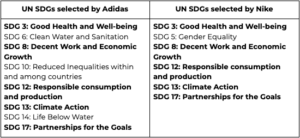In a world saturated with big-name brands, Adidas and Nike are two sportswear giants that have found success in the apparel sector. Inevitably, they are rivals and it would be hard to find someone who does not own a single item from either brand.
But in terms of sustainability, which one is best?
The Impakter Index enables us to answer that question. But first, it helps to understand what are the issues they, or for that matter, other brands seeking to become sustainable, are facing in an industry where “fast fashion” has become a key phrase and a broadly adopted business model.
Are Nike and Adidas fast fashion?
By definition, the term “fast fashion” describes a design, manufacturing, and marketing method whereby large quantities of clothing are produced at a rapid rate. The production focuses on trend replication and often lower-quality materials are used to sell inexpensive wear to the public.
This consumer-based culture leads to damaging effects on the environment. Unfortunately, and this is a cause of despair for those of us concerned with sustainability, fast fashion infiltrates most wardrobes. But what are Adidas and Nike doing to combat this “throwaway” culture? Which brand has adopted the most achievable sustainability practices and which one is on target?
When comparing the two, Nike is the larger business and the market leader in global sports and footwear. Their revenues from their footwear alone reached over $24.2 billion in 2018, in comparison to Adidas’s footwear revenue of $15 billion.
But, what do the figures mean in terms of the two companies’ goals for achieving sustainability?
Is Adidas sustainable?
The sportswear industry is renowned for producing a considerable amount of material and energy waste during the manufacturing process. And that is what Adidas is focused on, working to address its environmental impact by making sustainability apparent in their business structure, with a specific focus on low emissions, waste, and reducing water. In their own words:
“Plastic today. A problem tomorrow. As we continue to address our overall carbon footprint, we’re shifting to use 100% recycled polyester in our products by 2024. This is bigger than sport, this is for our future.”
They are committed to reducing and ultimately ending plastic waste, a goal they plan to realize through their innovative solutions and partnerships. Key to enact change is their Three Loop Strategy focuses the brand’s efforts on creating three categories of sustainable products and processes:
Recycled Loop – made from recycled materials: includes materials such as Parley Ocean Plastic, with the aim to eliminate the use of virgin polyester by 2024.
Circular Loop – made to be remade: this category includes products that are designed to have multiple life cycles, like the Futurecraft.Loop running shoe.
Regenerative Loop – made with nature: reflects our ambition to create a future where every Adidas product can have multiple lives and then return to nature.
In 2020, they made a pointed effort to broaden their range of sustainable products and in Germany, they already source all of their electricity from renewable sources (not surprisingly, as German fashion brands are high-achievers when it come to sustainability efforts, see also Hugo Boss sustainability policy).
Additionally, they are ahead of their target to remove all virgin polyester from their products by 2024. Furthermore, the company’s carbon footprint will be reduced by 30% by 2030 (compared to 2017) as well as maintaining the goal for climate neutrality by 2050.
Is Nike sustainable? Nike’s Multi-faceted Approach
In comparison, Nike is following a multi-faceted approach, reaching out in various directions but ultimately with unsatisfactory results.
Nike is part of the Fashion Industry Charter for Climate Action, a commitment under the United Nations Framework Convention on Climate Change.
Aside from this, Nike has also joined UN Climate Change and global brands, retailers, and suppliers in fast-tracking some of the industry’s most forceful climate targets yet. These include 30% reductions in aggregate greenhouse gas emissions by 2030 as well as a vision to achieve net-zero emissions by 2050.
Is Nike greenwashing? Well…
However, upon assessing some of Nike’s main policies, it seems more of a marketing campaign and performative activism disguised as new initiatives (greenwashing much?)
As an industry giant, it seems Nike could be doing more in paving the way to make considerable changes in the apparel sector. Other brands, like The North Face and Patagonia, are faring much, much better, when it comes to sustainability.
Nike lacks any sustainability-related awards and certificates. Despite this, our Index team has revealed that they do comply with some of the United Nations Sustainable Development Goals – (SDG 3, 5, 8, 12, 13, 17).
Related Articles: Is Mango as fast fashion as Zara? | Are Louis Vuitton and Gucci moving toward sustainability? |
Nike does use several environmentally friendly materials including organic and recycled cotton, polyester, as well as minimizing off-cuts during the manufacturing process. Moreover, Nike has in place a water management strategy throughout most of its supply chain.
But Nike environmental impact is still a matter of concern. The company still applies harmful hazardous chemicals, which have been denounced by Greenpeace. As a result, when comparing Adidas’ Three Loop Strategy, Nike’s attempt at sustainability appears to be little more than greenwashing,an accusation faced by other fashion giants like Uniqlo (though they do a bit better than Nike to be fair) and Chanel.
Despite the recognition of some SDGs, most notably their work geared towards Gender Equality and their employees’ rights, their manufacturing and supply chains are fundamentally problematic.
Therefore, Nike falls short in areas of sustainability such as basic human rights, worker’s rights, supply chain management, pollution and toxins, habitats & resources, environmental reporting, use of controversial technologies, anti-social finance, and animal rights. At least they didn’t face dire accusations like Shein.
So how do Adidas and Nike fare in the race to improve sustainability?
In order to ascertain answers, we can turn to the Impakter Sustainability Index that allows us to directly compare both brands. The research compiled by the Impakter Index Team provides a clear overview of both brand’s sustainability practices, goals, and achievements. The ratings awarded to each brand confirm and reinforce the information already discussed above.
Nike SDGs compliance
In addition to the overall sustainability ratings, the Index also highlights other directly comparable factors about each brand. Adidas has been awarded nine certifications compared with one for Nike and they also comply with eight SDGs, whereas Nike only complies with five.
The only SDG Nike achieves instead of Adidas is SDG 5, “Gender Equality”, but there is room for contention as to whether the brand is actually working to achieve this goal. While the brand has announced its gender equality values, they have been accused of a toxic culture of gender discrimination and sexual harassment made by former employees who sued Nike in 2018.
The following table shows – on the basis of the certificates they have received – towards which UN Sustainable Development Goals each brand is working (shared goals are highlighted in bold):

Adidas SDGs compliance
The SDGs chosen by Adidas are more focused and comprehensive than Nike’s, and there is evidence from Adidas that these are being achieved.
Their action does not appear to be simply performative examples of greenwashing. Instead, they have enacted real positive change.
For example, in compliance with SDG 14, the brand has worked to reduce the amount of virgin plastic added to the world and it has contributed towards cleaning up already existing plastic. Additionally, the Adidas brand more than doubled the number of products made with recycled ocean plastic from seven million in 2018 to more than 14 million in 2019.
The SDGs each brand has selected for itself has set out a different path for each to achieve sustainability, as the following table shows:

Some aspects are striking. For example, Adidas has clearly communicated its goals towards sustainability, yet the company does not provide clear KPIs.
Adidas has numerous listings (Dow Jones Sustainability Index, FTSE4Good, MSCI Global sustainability, and more) and some certifications (LEED, ISO, OSHAS), but the company does not hold primary sustainability recognitions. That is to say, there is no independently certified recognition that the company’s mode of production is in fact sustainable.
In short, if Adidas continue to achieve their goals and successfully follow through on their targets, they have the chance to become A-rated.
By contrast, Nike, despite using certain environmentally friendly fabrics, including recycled materials, overlooks wastewater discharges and has been denounced by Greenpeace for failing to get rid of hazardous chemicals in their supply chain.
Is Adidas more sustainable than Nike?
For these reasons, Adidas is currently in the lead in the race to be the more sustainable sportswear brand out of the two, despite Nike boasting a larger annual revenue and company profile.
But both Adidas and Nike have a way to go to achieve sustainability: It is clear that far more efforts are required as well as a far greater degree of transparency. As for , at times Nike has somewhat fell in the greenwashing camp.
Most importantly, what is urgently needed for both of them is independent certification of their sustainability measures and results. That will be the only way to build trust among their consumers and put to rest criticisms that they are engaged in sophisticated greenwashing.










